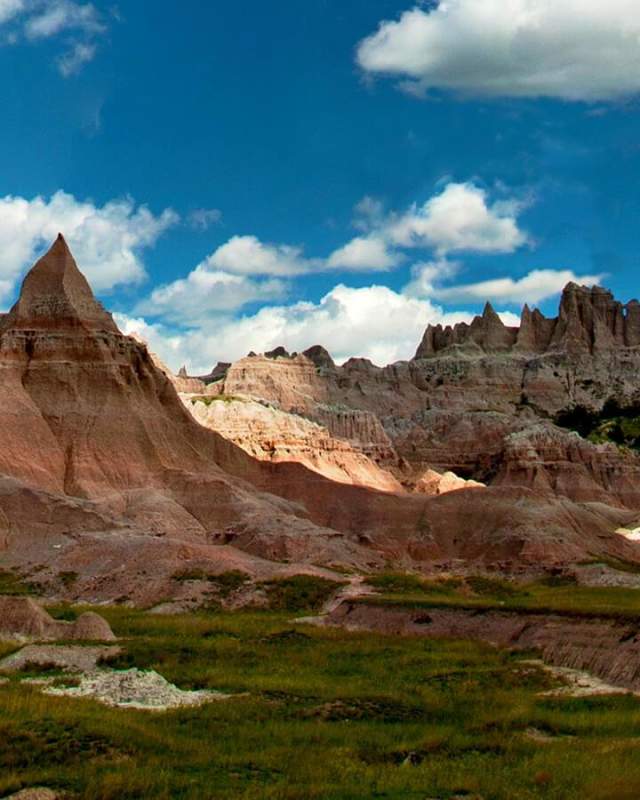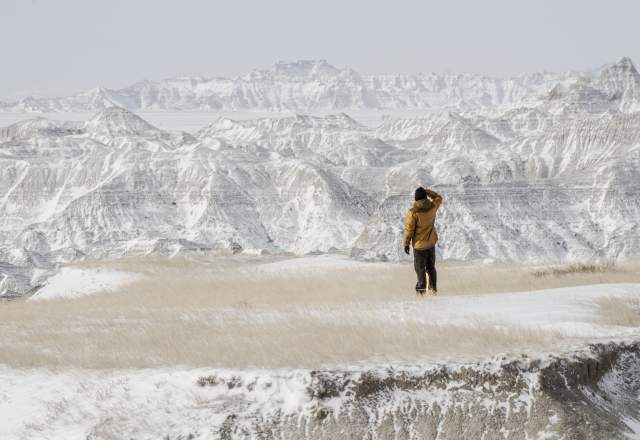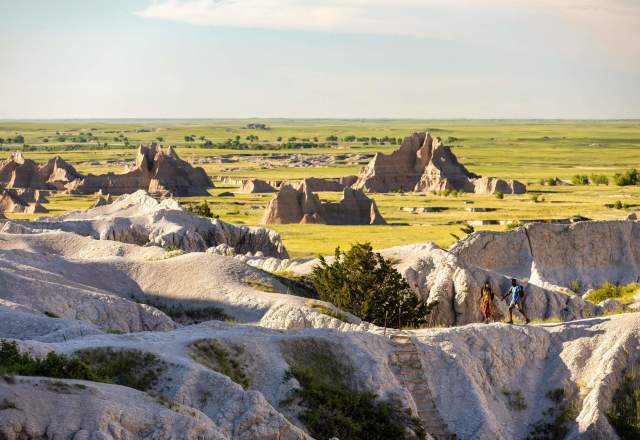Badlands National Park
Drive 60 minutes east of Rapid City and you’ll find yourself surrounded by terrain that can only be described as other-worldly. Badlands National Park spans for 244,000-acres and is famous for its stunning vistas, wildlife encounters, outdoor activities, and stargazing opportunities. Open year round, Badlands National Park is a sight to see in every season and a standout among Rapid City area parks and monuments. Take a drive through the park and soak up the landscape that sprawls out from each scenic overlook and around every twist and turn, unveiling unique geological formations and mixed grass prairie. Add to the experience by visiting during sunrise or sunset to witness a terrain that’s as colorful as it is desolate. This often underestimated park continues to blow away its visitors and is an ideal place to celebrate the wonders of nature.
-
- $30/Private Vehicle Week Long Pass
- $15/Individual (Hiking, Bicycling, etc.) Week Long Pass
- $25/Motorcycle Week Long Pass
- $50/Private Vehicle Annual Pass
- Commercial sedan, 1 to 6 passenger capacity. $25 plus $10 per person - 7 days for Original Manifest
- Commercial van, 7 to 15 passenger capacity; $50 - 7 days for Original Manifest
- Minibus, 16 to 25 passenger capacity; $60 - 7 days for Original Manifest
- Motorcoach, 26 or more passenger capacity; $150 - 7 days for Original Manifest
-
Ben Reifel Visitor Center
You’ll find exhibits and an informational video at the Visitor Center, along with a bookstore offering resources, gifts, and educational materials. Located on the Badlands Loop Road (Highway 240) at its southeastern tip, next to Cedar Pass Lodge.
Season Hours:- 8:00 a.m. – 4:00 p.m. (Winter Hours)
- 8:00 a.m. – 5:00 p.m. (mid-April to mid-May)
- 8:00 a.m. – 7:00 p.m. (Summer Hours)
- 8:00 a.m. – 5:00 p.m. (early September to late October)
- Closed Thanksgiving, Christmas Day, and New Year's Day
Ranger Programs
Seasonal, daily ranger-led programs offer walks, talks, and presentations about geology, paleontology, fossils, night sky viewing, and more. Ask for updated info at the Visitor Center, including the Junior Ranger Program.
Badlands Loop State Scenic Highway
The grandeur and diverse landscape of the Badlands is ideal for cruising, and Highway 240 gives you the perfect vantage point at every turn of a 30-mile loop. Nearly 30 scenic overlooks provide impressive photo opportunities.
Sage Creek Rim Road
Turn off the western end of the Badlands Loop Road onto the Sage Creek Rim Road, where outdoor photography enthusiasts find diverse wildlife, including buffalo, pronghorn antelope, mule deer, prairie dogs, and numerous birds.
Fossil Sites
Badlands National Park is among the area’s most popular archeology and paleontology attractions. Fossil hunting is allowed in the park, as long as you leave all discoveries right where you find them, along with all rocks and minerals. Visit the Fossil Preparation Lab to watch paleontologists at work. A fully accessible boardwalk trail features fossil replicas and exhibits of extinct creatures.
Stargazing
See the summer sky as never before, with a ranger-guided Night Sky Program helping you identify what’s out there in the heavens. Telescopes are provided, along with a spectacular viewing experience, thanks to the Badlands’ isolation and absence of artificial lighting.
Prairie Dog Town
Prairie Dog Town is on the Sage Creek Rim Road, where a homestead has been converted to a massive network of tunnels where you can see black-tailed prairie dogs up close. They join 39 mammal species of the prairie animals that thrive in Badlands National Park, along with various reptiles, amphibians, birds, and 69 butterfly species.
Hiking
A variety of designated hiking trails let you explore Badlands National Park at a deeper level. It’s a good idea to check in at the Ben Reifel Visitor Center for recommendations that suit your experience level. Bicycling is also popular in the park, with resources available to help you plan the right course.
-
The geologic processes of deposition and erosion is what created the bizarre terrain found in Badlands National Park. Deposition is the buildup of sediment, soil, and rocks, and this process began about 75 million years ago. Erosion is the process of these layers wearing away, which began about 500,000 years ago. In fact, according to the Badlands National Park website, the formations in this park are eroding away at a rate of one inch per year.
When the Lakota first discovered this intimidating landscape, they called the area “mako sica” or “land bad.” Important hunting grounds for 11,000 years, the Badlands continue to be a region of great spiritual significance to American Indians, making a visit an essential addition to your Native American Discovery journey.
The early Lakota found large fossilized bones, seashells, and turtle shells. As westward migration brought settlers, trappers, and hunters to the area, paleontological interest grew, making the White River Badlands popular fossil hunting grounds in the mid-1800s. The area contains the richest deposits of Oligocene mammals known, giving us a glimpse of the area’s residents 33 million years ago.
-
Pets are allowed in Badlands National Park, but with some restrictions. They must be kept on a leash, no longer than 6 feet, at all times, and are only allowed in developed areas such as campgrounds, picnic areas, and other areas open to motor vehicles. Pets are not allowed on hiking trails, in public buildings, and backcountry areas. Although prohibited on hiking trails, the park does offer other opportunities to take in great views with your four-legged family member.
More Good Stuff You'll Love
How To Experience Winter In Our Parks and Monuments
Winter at our area parks and monuments brings on entirely different experiences…
- 6 minute read
3 Reasons It’s Worth Visiting Badlands National Park
People have been drawn to explore the Badlands long before it became a National Park…
- 5 minute read
Why You Need To Spend A Day At Minuteman Missile National Historic Site
Located 60 miles east of Rapid City stands a fascinating, and terrifying, piece of…
- 3 minute read



